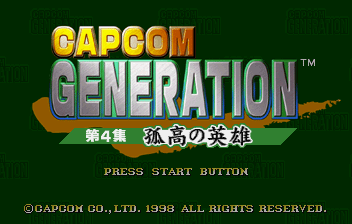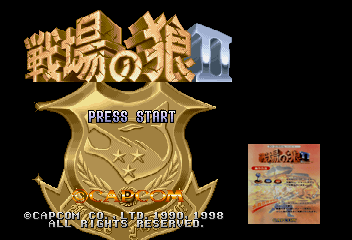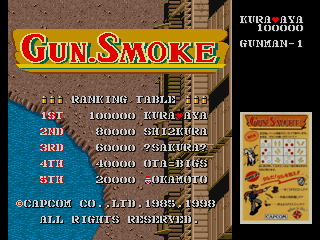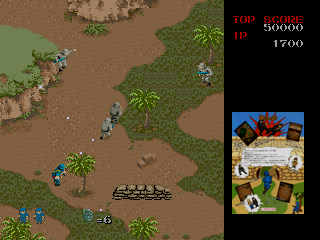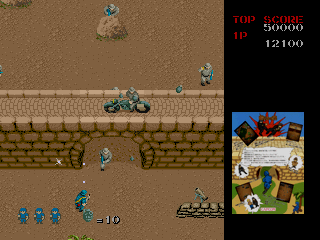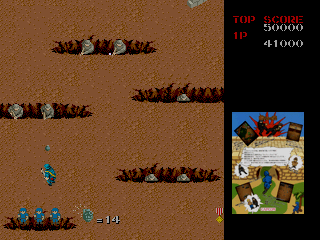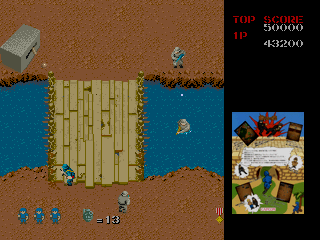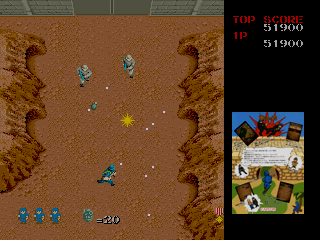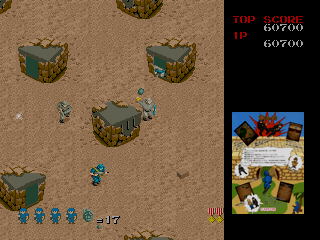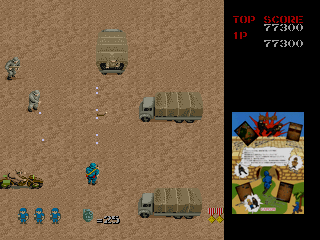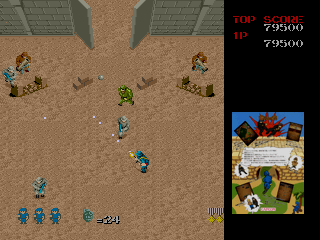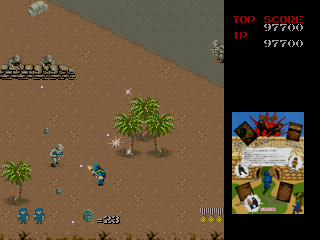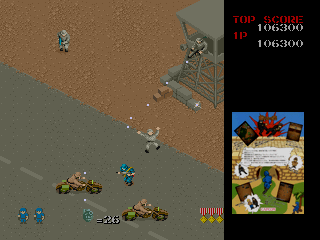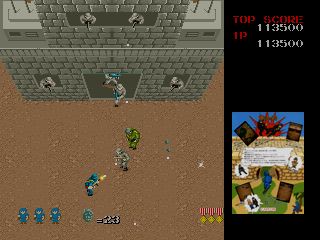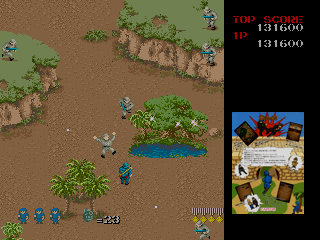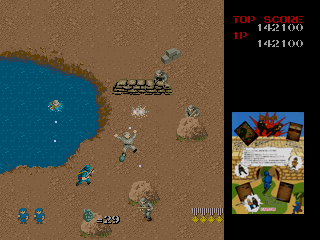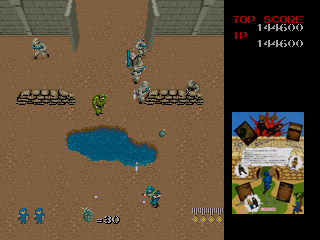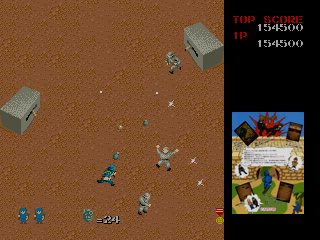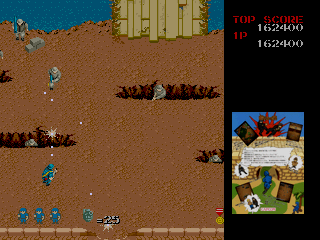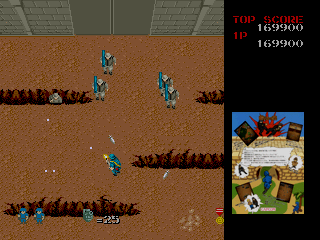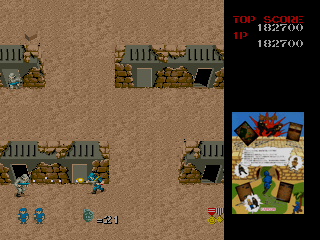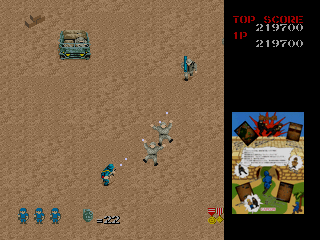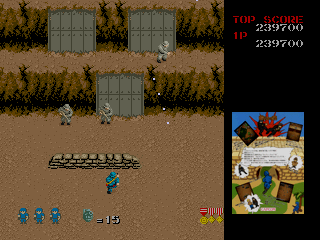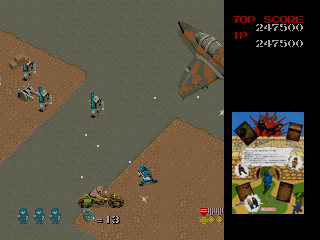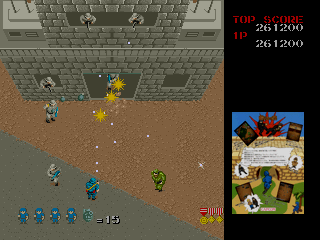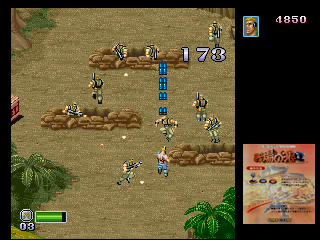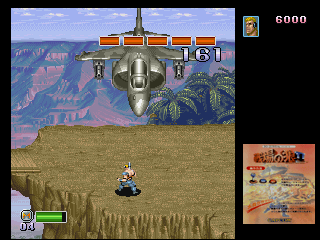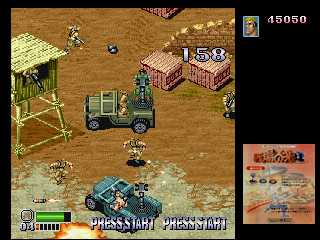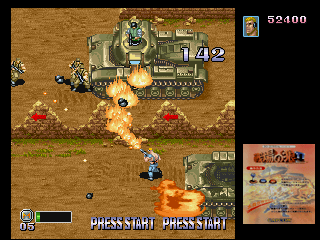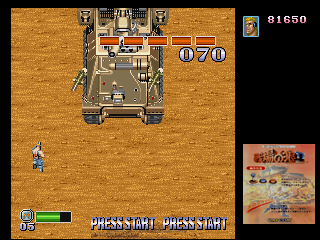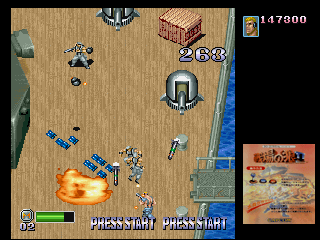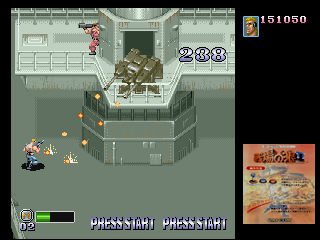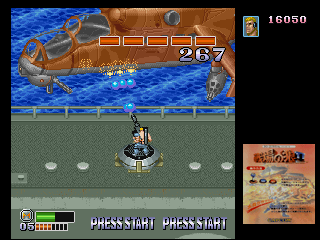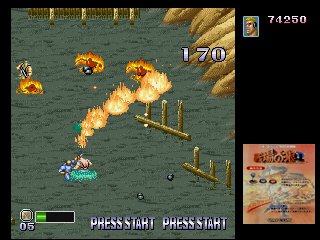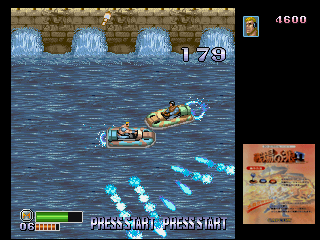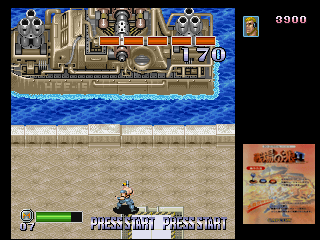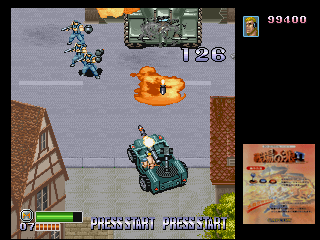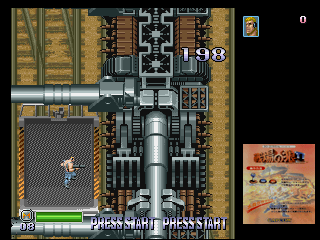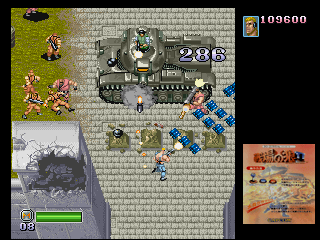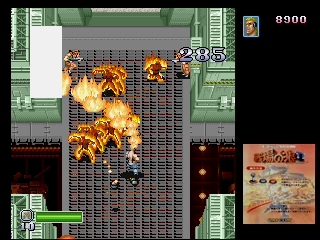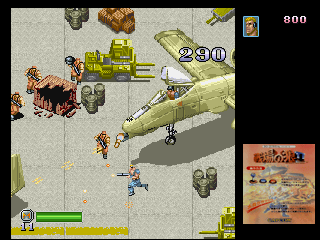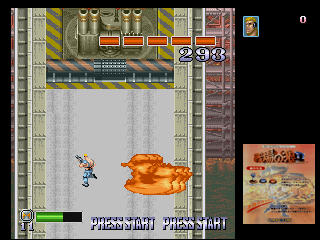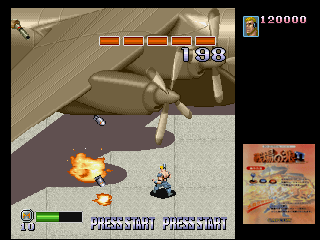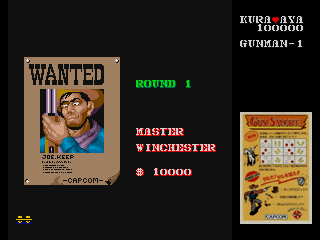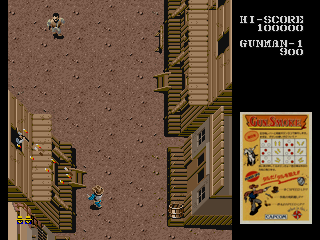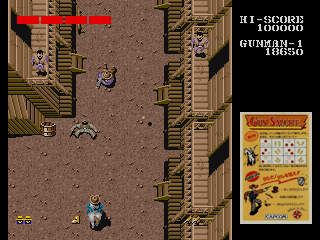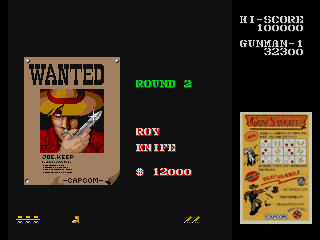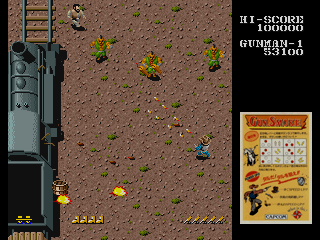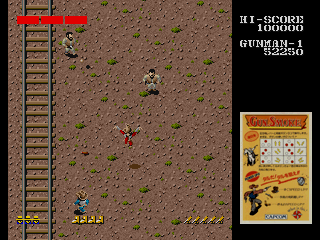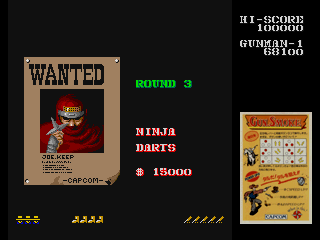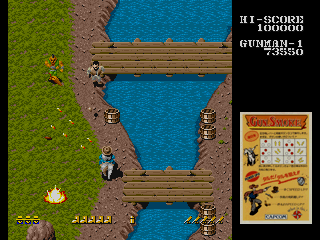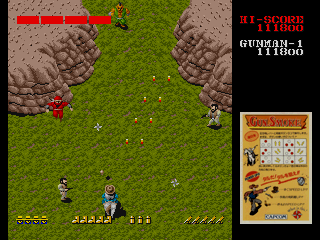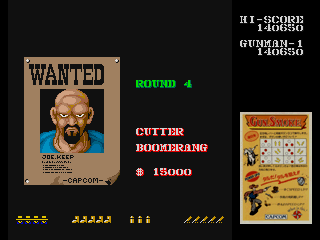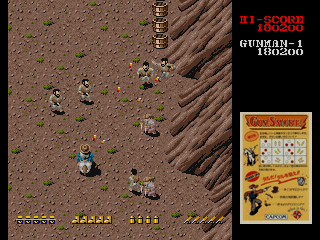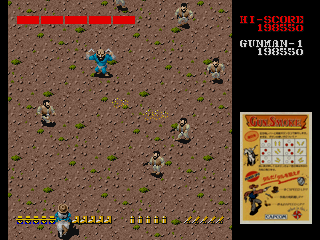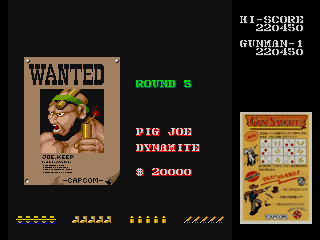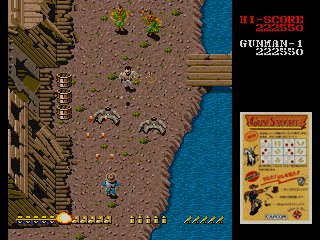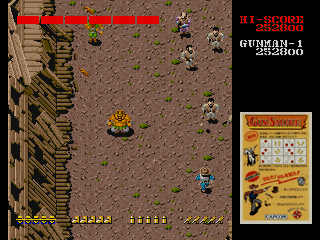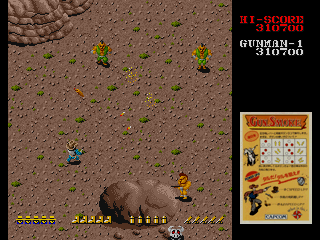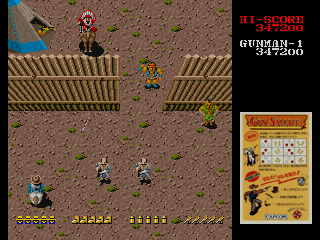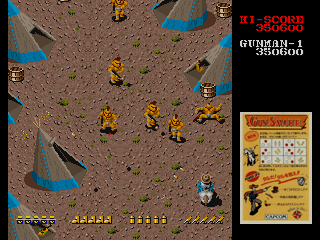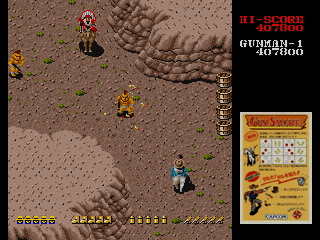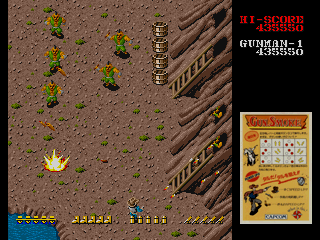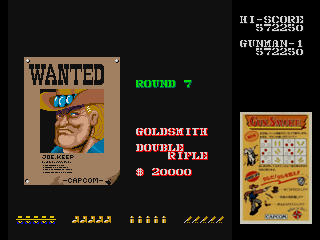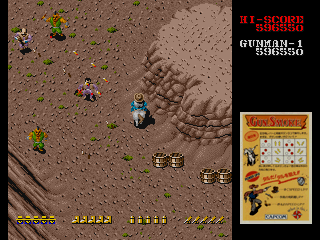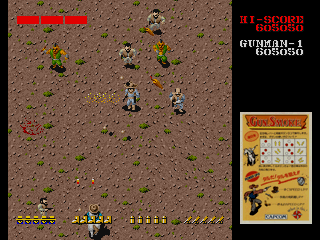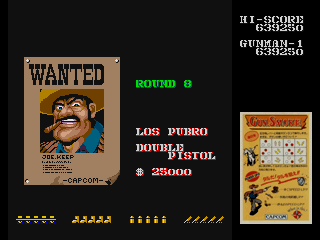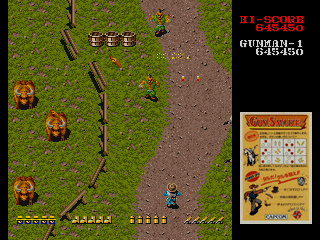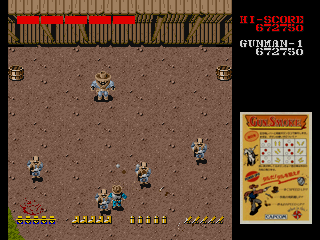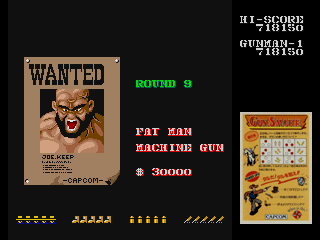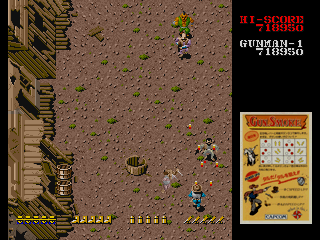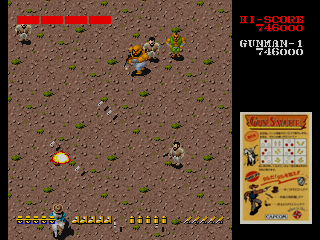Capcom Generation: Dai 4 Shuu Kokou no Eiyuu
From Sega Retro
| ||||||||||
| Capcom Generation: Dai 4 Shuu Kokou no Eiyuu | ||||||||||
|---|---|---|---|---|---|---|---|---|---|---|
| System(s): Sega Saturn | ||||||||||
| Publisher: Capcom | ||||||||||
| Developer: Capcom | ||||||||||
| Original system(s): Capcom Commando Hardware, Capcom CPS-1, Capcom Gun.Smoke Hardware | ||||||||||
| Game total: 3 | ||||||||||
| Sound driver: SCSP/CD-DA (64 tracks) | ||||||||||
| Peripherals supported: 6Player | ||||||||||
| Genre: Compilation, Shooting[1][2] | ||||||||||
| Number of players: 1-3 | ||||||||||
| ||||||||||
|
Capcom Generation: Dai 4 Shuu Kokou no Eiyuu (カプコン ジェネレーション 第4集 孤高の英雄) is the fourth of five compilations for the Sega Saturn (and PlayStation) developed by Capcom.
The fourth volume features three arcade top-down shooters.
Contents
Games included
- Commando (Senjou no Ookami; 戦場の狼)
- Mercs (Senjou no Ookami II; 戦場の狼II)
- Gun.Smoke (ガンスモーク)
Every game has a "Collection" with artwork (including promotional art and sprites), information, and a music player. Options and high scores can be saved to the Saturn's internal memory.
Gameplay
Commando
Commando is an overhead run-and-gun, originally released in 1985, where the player takes control of a soldier named Super Joe. At the beginning of the game, he is dropped into a jungle via helicopter. There are several stages, and Joe must fight his way to the top of each stage by fighting an assault of enemy soldiers, dodging their bullets and grenades as they pour in continuously. At the end of each stage, Joe fights waves of soldiers streaming from a gate or fortress. Shooting their commanding officer, who immediately runs away, awards bonus points. Along the way, the player can also free prisoners of war for bonus points as they are transported across the screen by the enemy. There is a two-player mode where players alternate turns, but there is no simultaneous play.
Super Joe moves in any direction using the D-Pad. The screen scrolls up as Joe moves further, but it does not scroll back down, so the player cannot backtrack. He is armed with an assault rifle with unlimited ammunition and a limited supply of hand grenades. Joe fires his gun with ![]() or
or ![]() , which can be aimed in any of the eight directions that he faces. His gun has limited range and shoots halfway up the length of the screen. He throws grenades with
, which can be aimed in any of the eight directions that he faces. His gun has limited range and shoots halfway up the length of the screen. He throws grenades with ![]() . Grenades are only thrown upwards, towards the top of the screen, regardless of which direction Joe is facing. They are tossed the same distance as his maximum rifle range. While they cannot hit anything along the way, they can be thrown to clear obstacles (such as over sandbags), and the explosion can kill multiple enemies at once.
. Grenades are only thrown upwards, towards the top of the screen, regardless of which direction Joe is facing. They are tossed the same distance as his maximum rifle range. While they cannot hit anything along the way, they can be thrown to clear obstacles (such as over sandbags), and the explosion can kill multiple enemies at once.
Joe is killed in one hit from an enemy or if he falls into water. He restarts from a checkpoint if he dies. Extra lives are given at 10,000 points, then every 50,000 points after that. The game ends if the player runs out of lives.
There are two difficulty levels, and the player can change the points thresholds for earning extra lives, enable three speeds of rapid-fire (off, low, normal, or high), or toggle continues. Since the original game uses a vertical aspect ratio, there are three screen modes: Type 1 interpolates the image to fit into the height of the Saturn's video mode, Type 2 (the default) crops the playfield to fit the screen, and Type 3 preserves the vertical aspect ratio (but requires the player to rotate the monitor).
Items
| Gives 1 grenade to Super Joe. | |
| Gives 3 grenades to Super Joe. |
Stages
First tour
| Stage 1 | |
|---|---|
| Stage 2 | |
| Stage 3 | |
| Stage 4 | |
Second tour
After completing the fourth stage, the game proceeds to more difficult versions of the same four stages. After completing these stages, the game loops again from the beginning with the normal versions of the stages.
| Stage 1 | |
|---|---|
| Stage 2 | |
| Stage 3 | |
| Stage 4 | |
Mercs
Mercs is another overhead run-and-gun and the sequel to Commando, originally released in 1990. It can be played by up to three players simultaneously. Players can join the game by pressing START on a second or third control pad (using a 6Player for three-player games). The players control members of an elite mercenary squad known as "Wolf Force," who must rescue a former President from rebels in the fictional African country of Zutula. The game has six levels, with a boss at the end of every one, plus a final level where the Mercs must rescue the President from a Hercules Transport before it escapes.
The Merc moves in any direction using the D-Pad. The screen scrolls up as the Merc moves further, but it does not scroll back down, so the player cannot backtrack. The Merc shoots his primary weapon with ![]() or
or ![]() . The Merc is initially equipped with an assault rifle but can switch weapons by collecting weapon pick-ups. Each Merc has a limited supply of Mega Crush Bombs that can be detonated with
. The Merc is initially equipped with an assault rifle but can switch weapons by collecting weapon pick-ups. Each Merc has a limited supply of Mega Crush Bombs that can be detonated with ![]() , which kills all on-screen enemies (or greatly damages a boss). Mega Crush Bombs can be replenished by finding bomb pick-ups. In some stages, the Mercs can commandeer vehicles or gun turrets.
, which kills all on-screen enemies (or greatly damages a boss). Mega Crush Bombs can be replenished by finding bomb pick-ups. In some stages, the Mercs can commandeer vehicles or gun turrets.
Each Merc has a vitality gauge that gradually depletes as they take damage from enemies. Some obstacles (such as walking onto mines or being run over by a vehicle) kill the Merc instantly. There are power-ups that restore lost health or permanently extend the maximum vitality. Some vitality is restored after completing a mission. When the Merc runs out of life or if time runs out, the game ends.
There are eight difficulty levels, and the player can enable three speeds of rapid-fire (off, low, normal, or high) or toggle continues. Since the original game uses a vertical aspect ratio, there are three screen modes: Type 1 interpolates the image to fit into the height of the Saturn's video mode, Type 2 (the default) crops the playfield to fit the screen, and Type 3 preserves the vertical aspect ratio (but requires the player to rotate the monitor).
Items
Items are found in crates.
| Crate | |
|---|---|
| Destroy to release an item. | |
| Food | |
| Restores 3 units of the life gauge. | |
| Medal | |
| Restores part of the life gauge. | |
| First Aid Box | |
| Restores 16 units of the life gauge. | |
| Life-Up | |
| Permanently adds 4 units to capacity of the life gauge. | |
| Power | |
| Upgrades the weapon power level. | |
| Mega Crush Bomb | |
| Gives the player another Mega Crush Bomb to use. | |
| Assault Rifle | |
| Switches the Merc's weapon to the assault rifle, which shoots bullets in the direction that the Merc is facing. This is the starting weapon. | |
| Flamethrower | |
| Switches the Merc's weapon to the flamethrower, which sprays a long flame that does continuous damage and can hit multiple targets. | |
| Shotgun | |
| Switches the Merc's weapon to the shotgun, which shoots multiple shots in a conical shape. | |
| Grenade Launcher | |
| Switches the Merc's weapon to the grenade launcher, which fires high-powered grenades a short distance. |
Missions
| Mission 1 | |
|---|---|
| Mission 2 | |
| Mission 3 | |
| Mission 4 | |
| Mission 5 | |
| Mission 6 | |
| Mission 7 | |
Gun.Smoke
Gun.Smoke is an overhead run-and-gun game that was originally released in 1985. The player controls a bounty hunter named Billie Bob in a Wild West setting as he tries to apprehend several dangerous outlaws for the reward money. Each round consists of Billy Bob walking through a frontier locale and being ambushed by numerous foes before facing the boss at the end. The boss is defended by endless waves of enemy goons, who all die when the boss is defeated. The player earns reward money (as points) when a boss is defeated. The game is noted for its high difficulty. There is a two-player mode where players alternate turns, but there is no simultaneous play.
Billy Bob moves in any direction using the D-Pad. The screen continually scrolls upward during a round, except during boss encounters. Billy Bob is armed with a pistol in each hand. The pistols have limited range (about half the length of the screen) but unlimited ammunition. He can fire them at several different angles depending on which button is pressed:
There are power-ups that increase Billy Bob's movement speed or increase the range and speed of his gunfire. He can also find a horse power-up that allows him to ride a horse.
Billy Bob is killed in one hit from an enemy. He restarts from a checkpoint if he dies, losing one level of his movement speed and attack upgrades. Uncommonly for the genre, Billy Bob cannot be harmed by being caught between impassable terrain (such as a mountain or body of water) and the screen as it scrolls, as he is instead moved safely onto pathable terrain. If he is mounted on horseback, he can sustain multiple hits before he loses the horse. Extra lives are given at 30,000 and 80,000 points, then every 80,000 points after that. The game ends if the player runs out of lives.
There are four difficulty levels, and the player can change the points thresholds for earning extra lives, enable three speeds of rapid-fire (off, low, normal, or high), or toggle continues. Since the original game uses a vertical aspect ratio, there are three screen modes: Type 1 interpolates the image to fit into the height of the Saturn's video mode, Type 2 (the default) crops the playfield to fit the screen, and Type 3 preserves the vertical aspect ratio (but requires the player to rotate the monitor).
Items
In addition to these items, other items appear that give bonus points when collected.
| Barrel | |
|---|---|
| Destroy to unveil an item that can be collected by walking over it. Not all barrels contain items. | |
| Boots | |
| Increases Billy Bob's movement speed, up to 5 times. | |
| Rifle | |
| Increases the range of Billy Bob's pistols, up to 5 times. | |
| Bullets | |
| Increases the firing rate of Billy Bob's pistols, up to 5 times. | |
| Horse | |
| Provides Billy Bob with a steed that protects him from 3 hits before he loses it. It flashes when it only has one hit left. The horse can be harmed by hazards such as water that normally do not affect Billy Bob. | |
| POW | |
| Kills every enemy on the screen (except for bosses). | |
| Cattle Skull | |
| Causes Billy Bob to lose one level of his movement speed and attack upgrades. | |
| Yashichi | |
| Gives the player an extra life. This symbol occurs frequently as a bonus item in Capcom games. | |
| These items award 1,000 bonus points when collected. | |
| These items award 10,000 bonus points when collected. | |
| This item awards 20,000 bonus points when collected. |
Rounds
| Round 1 | |
|---|---|
|
Boss: Master Weapon: Winchester Bounty: $10,000 | |
| Round 2 | |
|
Boss: Roy Weapon: Knife Bounty: $12,000 | |
| Round 3 | |
|
Boss: Ninja Weapon: Darts Bounty: $15,000 | |
| Round 4 | |
|
Boss: Cutter Weapon: Boomerang Bounty: $15,000 | |
| Round 5 | |
|
Boss: Pig Joe Weapon: Dynamite Bounty: $20,000 | |
| Round 6 | |
|
Boss: Wolf Chief Weapon: Shotgun Bounty: $80,000 | |
| Round 7 | |
|
Boss: Goldsmith Weapon: Double Rifle Bounty: $20,000 | |
| Round 8 | |
|
Boss: Los Pubro Weapon: Double Pistol Bounty: $25,000 | |
| Round 9 | |
|
Boss: Fat Man Weapon: Machine Gun Bounty: $30,000 | |
| Round 10 | |
|
Boss: Wingate Family Weapon: Machine Gun and Rifle Bounty: $80,000 | |
History
Release
This is the fourth release in the Capcom Generation series. The Sega Saturn versions of these games were exclusively released in Japan, but the PlayStation versions of the first four volumes were released in a bundle titled Capcom Generations in Europe (except for the German version, which omits the fourth volume).
Production credits
Mercs
- Planner: M.Akahori, N.Saito
- Chief Designer: S.Okano, A.Kume, M.Kijima
- Character Designer: H.Nishio, T.Hayashi, Y.Kakuta, H.Kisanuki, M.Nonaka, M.Kobayashi, Y.Katayama
- Sound: M.Gotoh
- Sound Programmer: Y.Sakaguchi
- Programmer: M.Akahori, T.Ohta, Y.Matsui
- Special Thanks: A.Yasuda, M.Yasuda, S.Yamashita, A.Kurihara, M.Okasaki, A.Nishituji, M.Fukumaru, K.Uchida, S.Ukai, J.Ohno, Y.Ohji, M.Kawamura, K.Kitayama, Y.Kyotani, N.Kojima, C.Kanemitsu, M.Sakurai, T.Nagato, E.Nishihara, S.Matumoto, H.Minobe, K.Yamamoto, K.Yamawaki, K.Yokota, S.Maxwell
- Presented by: Capcom
Magazine articles
Physical scans
| Sega Retro Average | |||||||||||||||||||||||||||||
|---|---|---|---|---|---|---|---|---|---|---|---|---|---|---|---|---|---|---|---|---|---|---|---|---|---|---|---|---|---|
|
| 57 | |
|---|---|
| Based on 5 reviews | |
Technical information
References
NEC Retro has more information related to Senjou no Ookami
|
- ↑ File:CapcomGeneration4 Saturn JP Box Back.jpg
- ↑ 2.0 2.1 https://sega.jp/history/hard/segasaturn/software_l.html#tab04 (Wayback Machine: 2019-12-07 02:59)
- ↑ File:Mercs Saturn credits.pdf
- ↑ Dreamcast Magazine, "1998-01 (1998-11-20)" (JP; 1998-11-06), page 180
- ↑ Famitsu, "1998-11-20" (JP; 1998-11-06), page 1
- ↑ Joypad, "Janvier 1999" (FR; 199x-xx-xx), page 80
- ↑ Saturn Fan, "1998 No. 21" (JP; 1998-11-06), page 145
- ↑ Sega Saturn Magazine, "Readers rating final data" (JP; 2000-03), page 14
| Capcom Generation: Dai 4 Shuu Kokou no Eiyuu | |
|---|---|
|
Main page | Comparisons | Magazine articles | Reception | Technical information
| |
